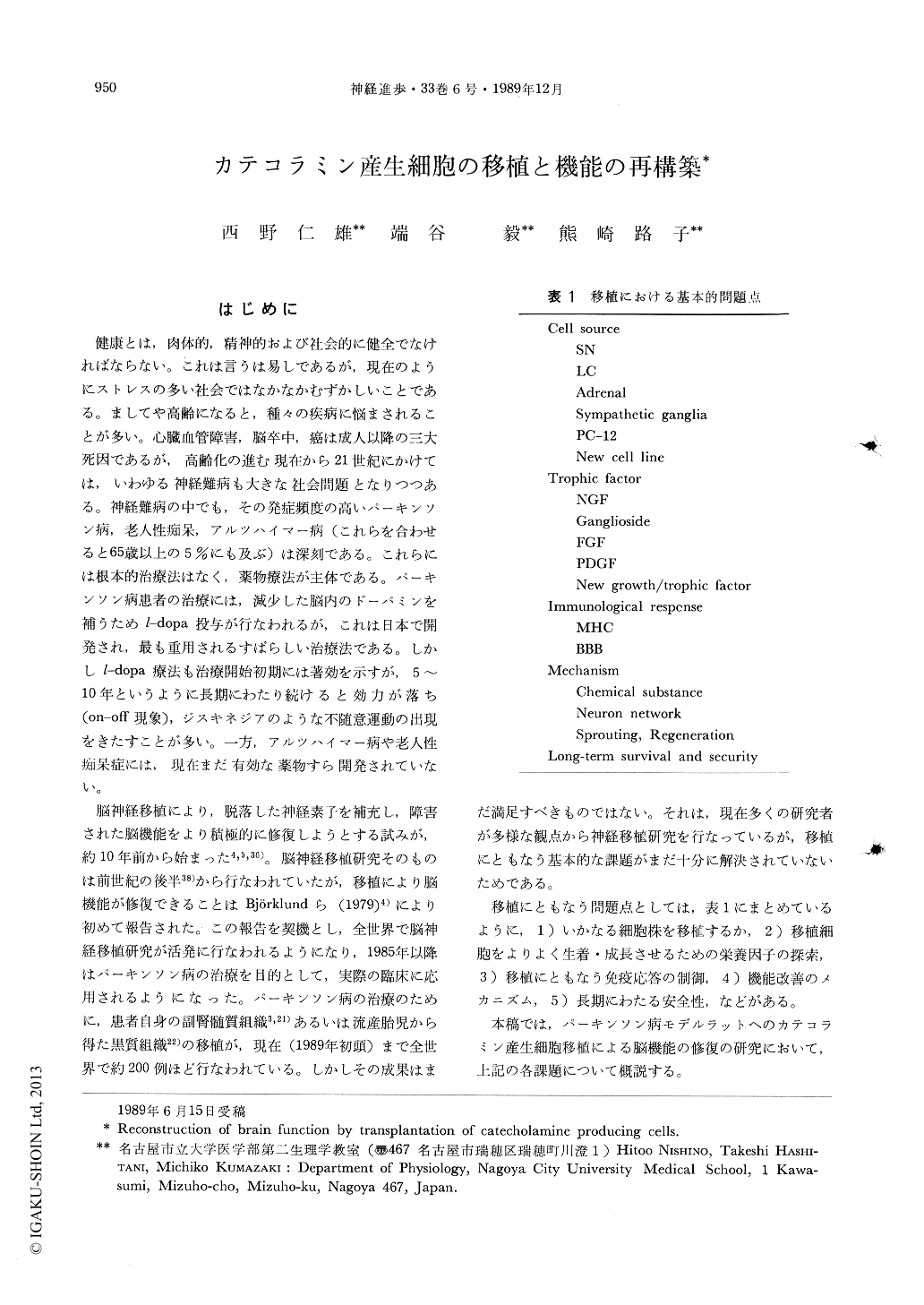Japanese
English
- 有料閲覧
- Abstract 文献概要
- 1ページ目 Look Inside
はじめに
健康とは,肉体的,精神的および社会的に健全でなければならない。これは言うは易しであるが,現在のようにストレスの多い社会ではなかなかむずかしいことである。ましてや高齢になると,種々の疾病に悩まされることが多い。心臓血管障害,脳卒中,癌は成人以降の三大死因であるが,高齢化の進む現在から21世紀にかけては,いわゆる神経難病も大きな社会問題となりつつある。神経難病の中でも,その発症頻度の高いパーキンソン病,老人性痴呆,アルツハイマー病(これらを合わせると65歳以上の5%にも及ぶ)は深刻である。これらには根本的治療法はなく,薬物療法が主体である。パーキンソン病患者の治療には,減少した脳内のドーパミンを補うためl-dopa投与が行なわれるが,これは日本で開発され,最も重用されるすばらしい治療法である。しかしl-dopa療法も治療開始初期には著効を示すが,5〜10年というように長期にわたり続けると効力が落ち(on-off現象),ジスキネジアのような不随意運動の出現をきたすことが多い。一方,アルツハイマー病や老人性痴呆症には,現在まだ有効な薬物すら開発されていない。
脳神経移植により,脱落した神経素子を補充し,障害された脳機能をより積極的に修復しようとする試みが,約10年前から始まった4,5,36)。脳神経移植研究そのものは前世紀の後半38)から行なわれていたが,移植により脳機能が修復できることはBjorklundら(1979)4)により初めて報告された。この報告を契機とし,全世界で脳神経移植研究が活発に行なわれるようになり,1985年以降はパーキンソン病の治療を目的として,実際の臨床に応用されるようになった。パーキンソン病の治療のために,患者自身の副腎髄質組織3,21)あるいは流産胎児から得た黒質組織22)の移植が,現在(1989年初頭)まで全世界で約200例ほど行なわれている。しかしその成果はまだ満足すべきものではない。それは,現在多くの研究者が多様な観点から神経移植研究を行なっているが,移植にともなう基本的な課題がまだ十分に解決されていないためである。
Catecholamine producing cells (suspension of nigral dopaminergic cells, locus coeruleus noradrenergic cells, adrenal chromaffin cells) were transplanted in ipsilateral caudate nucleus of rats with unilateral 6-OHDA lesions in the nigrostriatal dopamine pathway. Survival of grafted cells, their connections with host neuronal elements, dopamine synthesis/release, and recovery from motor disturbances were investigated for more than 2 years. Motor disturbances, assessed by methamphetamine circling, recovered inmore than 90% of animals by grafting nigral dopaminergic cells, in 40 to 60% of animals by grafting locus coeruleus noradrenergic cells, and in 0 to 30% of animals by grafting adrenal chromaffin cells. Many tyrosine hydroxylase (TH) positive cells survived in the host caudate following dopaminergic cell grafting. Following the grafting of locus coeruleus noradrenergic cells, moderate number of TH positive but dopamine β hydroxylase (DBH) negative cells survived in animals that made behavior recovery. A fewer TH positive cells survived following the grafting of adrenal medullary cells. These TH positive cells made synaptic connections with host neuronal elements. By in vivo microdialysis-HPLC analysis, extracellular dopamine and its metabolites around the grafting sites recovered in 50 to 100% of those of controls. Using TH cDNA probe, TH positive cells were found to express TH mRNA in in situ hybridization-autoradiography analysis. Data indicate that grafted catecholaminergic cells survive, synthesis and release dopamine, make connections with host neurons and ameliorate motor disturbances for over long term.

Copyright © 1989, Igaku-Shoin Ltd. All rights reserved.


